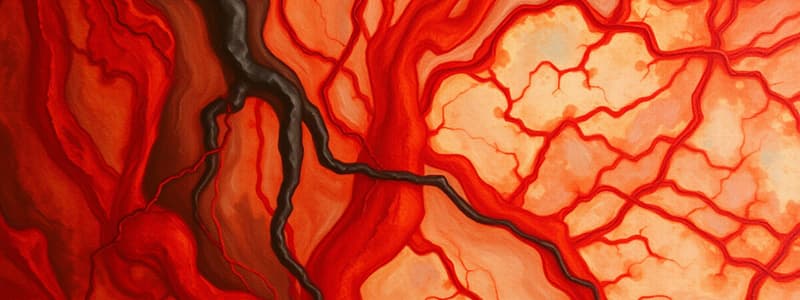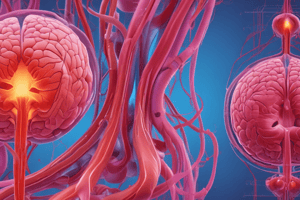Podcast
Questions and Answers
Which of the following symptoms is associated with decompensated shock?
Which of the following symptoms is associated with decompensated shock?
- SPO2 within normal limits
- Weak pulse (correct)
- Elevated heart rate
- Respiratory rate of 14-20
What is the blood loss range for Stage II shock?
What is the blood loss range for Stage II shock?
- 1500-2000 ml
- 750-1500 ml (correct)
- >2000 ml
- Up to 750 ml
Which characteristic indicates Stage IV shock?
Which characteristic indicates Stage IV shock?
- Heart rate of 140
- Respiratory rate of 20-30
- Pulses are +1 or none (correct)
- Blood pressure within normal limits
What happens to blood flow to the extremities during shock?
What happens to blood flow to the extremities during shock?
What is one of the signs of irreversible shock?
What is one of the signs of irreversible shock?
What is the primary clinical condition resulting from inadequate tissue perfusion?
What is the primary clinical condition resulting from inadequate tissue perfusion?
Which of the following can be an extrinsic factor leading to inadequate tissue perfusion?
Which of the following can be an extrinsic factor leading to inadequate tissue perfusion?
What is a possible physiological effect of severe shock on blood levels?
What is a possible physiological effect of severe shock on blood levels?
Which stage in the treatment for shock involves monitoring hemodynamics?
Which stage in the treatment for shock involves monitoring hemodynamics?
What is a common consequence of shunting of blood during hypoperfusion?
What is a common consequence of shunting of blood during hypoperfusion?
Which of the following describes a metabolic effect of anaerobic metabolism during severe shock?
Which of the following describes a metabolic effect of anaerobic metabolism during severe shock?
What does an increase in WBC counts indicate in the context of inadequate tissue perfusion?
What does an increase in WBC counts indicate in the context of inadequate tissue perfusion?
What is one potential treatment approach to address preload in cases of shock?
What is one potential treatment approach to address preload in cases of shock?
What is the primary role of Aldosterone in the RAAS system?
What is the primary role of Aldosterone in the RAAS system?
Which type of shock is primarily caused by a loss of blood volume?
Which type of shock is primarily caused by a loss of blood volume?
Which medication is classified as an inotropic agent that increases contractility?
Which medication is classified as an inotropic agent that increases contractility?
What is the primary physiological effect of the sympathetic nervous system during a 'fight or flight' response?
What is the primary physiological effect of the sympathetic nervous system during a 'fight or flight' response?
Which of the following treatments is appropriate for managing obstructive shock from a tension pneumothorax?
Which of the following treatments is appropriate for managing obstructive shock from a tension pneumothorax?
What effect does Epinephrine have on heart rate?
What effect does Epinephrine have on heart rate?
Which of the following parameters is typically indicative of low preload?
Which of the following parameters is typically indicative of low preload?
In the context of organ perfusion, what does DPF represent?
In the context of organ perfusion, what does DPF represent?
Which of the following conditions can lead to impaired cardiac output?
Which of the following conditions can lead to impaired cardiac output?
What is a common sign of septic shock?
What is a common sign of septic shock?
Which type of shock is characterized by loss of sympathetic tone and massive vasodilation?
Which type of shock is characterized by loss of sympathetic tone and massive vasodilation?
What can result from exposure to allergens in non-anaphylactic shock?
What can result from exposure to allergens in non-anaphylactic shock?
Which of the following signs is NOT associated with septic shock?
Which of the following signs is NOT associated with septic shock?
What distinguishes spinal shock from neurogenic shock?
What distinguishes spinal shock from neurogenic shock?
What is a common treatment for anaphylactic shock?
What is a common treatment for anaphylactic shock?
Which of the following factors can lead to generalized vasodilation?
Which of the following factors can lead to generalized vasodilation?
What is the most common cause of neurogenic shock?
What is the most common cause of neurogenic shock?
Which assessment finding is typically associated with dyspnea in cardiac tamponade?
Which assessment finding is typically associated with dyspnea in cardiac tamponade?
What is a common feature of dissociative shock?
What is a common feature of dissociative shock?
Which of the following is NOT a symptom of neurogenic shock?
Which of the following is NOT a symptom of neurogenic shock?
Which condition can lead to impaired cardiac filling during diastole?
Which condition can lead to impaired cardiac filling during diastole?
Which drug class's ingestion is associated with causing neurogenic shock?
Which drug class's ingestion is associated with causing neurogenic shock?
What does Beck's triad indicate in the context of cardiac tamponade?
What does Beck's triad indicate in the context of cardiac tamponade?
Which of the following is a common cause of oxygen-carrying impairment in dissociative shock?
Which of the following is a common cause of oxygen-carrying impairment in dissociative shock?
What is one of the potential signs associated with Stage III shock?
What is one of the potential signs associated with Stage III shock?
Which statement accurately describes changes in blood flow during shock?
Which statement accurately describes changes in blood flow during shock?
What distinguishes compensated shock from decompensated shock?
What distinguishes compensated shock from decompensated shock?
In which stage of shock is the respiratory rate elevated to greater than 35?
In which stage of shock is the respiratory rate elevated to greater than 35?
Which symptom would NOT typically be observed in a patient experiencing irreversible shock?
Which symptom would NOT typically be observed in a patient experiencing irreversible shock?
Which parameter is indicative of high preload?
Which parameter is indicative of high preload?
Which of the following treatments is most appropriate for managing hypovolemic shock following trauma?
Which of the following treatments is most appropriate for managing hypovolemic shock following trauma?
In the context of cardiac output, what does the term 'contractility' refer to?
In the context of cardiac output, what does the term 'contractility' refer to?
Which of the following medications is categorized as a chronotropic agent?
Which of the following medications is categorized as a chronotropic agent?
Which hormone is primarily responsible for water uptake in the kidneys to maintain blood pressure?
Which hormone is primarily responsible for water uptake in the kidneys to maintain blood pressure?
What is the role of the RAAS system in the body?
What is the role of the RAAS system in the body?
Which type of shock is caused by a blockage of blood flow, such as in a tension pneumothorax?
Which type of shock is caused by a blockage of blood flow, such as in a tension pneumothorax?
In terms of hemodynamics, which factor primarily determines the systemic vascular resistance (SVR)?
In terms of hemodynamics, which factor primarily determines the systemic vascular resistance (SVR)?
What is a primary consequence of fluid accumulation in the pericardial sac?
What is a primary consequence of fluid accumulation in the pericardial sac?
Which symptom is primarily associated with tension pneumothorax?
Which symptom is primarily associated with tension pneumothorax?
What physiological change occurs as a direct result of neurogenic shock?
What physiological change occurs as a direct result of neurogenic shock?
Which condition is characterized by normal heart and volume, but impaired oxygen delivery to tissues?
Which condition is characterized by normal heart and volume, but impaired oxygen delivery to tissues?
What is the primary hemodynamic effect of cardiac tamponade?
What is the primary hemodynamic effect of cardiac tamponade?
Which of the following is a key assessment finding indicative of dysregulated blood flow during shock?
Which of the following is a key assessment finding indicative of dysregulated blood flow during shock?
In which condition might you observe Beck's triad?
In which condition might you observe Beck's triad?
What is the primary defect in oxygen delivery during carbon monoxide poisoning?
What is the primary defect in oxygen delivery during carbon monoxide poisoning?
What is a direct consequence of hypoperfusion on cellular metabolism?
What is a direct consequence of hypoperfusion on cellular metabolism?
Which of the following is NOT a factor that can lead to inadequate tissue perfusion?
Which of the following is NOT a factor that can lead to inadequate tissue perfusion?
What is one of the primary physiological changes that results from severe shock?
What is one of the primary physiological changes that results from severe shock?
Which type of shock is characterized by massive vasodilation and a release of inflammatory mediators?
Which type of shock is characterized by massive vasodilation and a release of inflammatory mediators?
What happens to lactate levels during anaerobic metabolism due to inadequate tissue perfusion?
What happens to lactate levels during anaerobic metabolism due to inadequate tissue perfusion?
What is indicated by an increase in inflammatory process and clotting cascade during shock?
What is indicated by an increase in inflammatory process and clotting cascade during shock?
Which of the following conditions is specifically associated with a negative base deficit during severe shock?
Which of the following conditions is specifically associated with a negative base deficit during severe shock?
In the context of hemodynamics, what does MAP stand for?
In the context of hemodynamics, what does MAP stand for?
Which factor is specifically associated with neurogenic shock?
Which factor is specifically associated with neurogenic shock?
Which condition is NOT typically a cause of impaired cardiac output?
Which condition is NOT typically a cause of impaired cardiac output?
What clinical sign is commonly associated with septic shock?
What clinical sign is commonly associated with septic shock?
In the context of shock, which of the following indicates a condition where ALOC (Altered Level of Consciousness) is a symptom?
In the context of shock, which of the following indicates a condition where ALOC (Altered Level of Consciousness) is a symptom?
Which of the following symptoms would NOT typically be present in anaphylactic shock?
Which of the following symptoms would NOT typically be present in anaphylactic shock?
Which treatment is appropriate for someone experiencing neurogenic shock due to spinal injury?
Which treatment is appropriate for someone experiencing neurogenic shock due to spinal injury?
Which type of shock is primarily characterized by fluid shifts leading to decreased preload?
Which type of shock is primarily characterized by fluid shifts leading to decreased preload?
Which of the following substances is NOT typically associated with allergic reactions in shock conditions?
Which of the following substances is NOT typically associated with allergic reactions in shock conditions?
Flashcards are hidden until you start studying
Study Notes
Inadequate Tissue Perfusion & Impaired Oxygen Delivery
- Clinical syndrome driven by insufficient tissue perfusion, often leading to hypoperfusion.
- Causes include decreased blood volume, circulatory stagnation, illnesses, trauma, stress, dehydration, and environmental exposures.
- Shunting of blood can bypass capillary exchange beds, impairing aerobic metabolism (Krebs Cycle).
Physiological Changes
- Increased carbon dioxide and lactate levels due to inadequate aerobic metabolism.
- Enhanced inflammatory response and activation of clotting cascades in hypoperfused areas.
- Damage to endothelial cells triggers white blood cell activity.
- Severe shock can cause widespread inflammatory responses, particularly in septic shock.
Shock Management
- Identify the cause and type of shock, monitor hemodynamics, and implement treatment strategies.
- Key treatment strategies include restoring preload (fluid resuscitation).
Hemodynamics and Shock Types
- Shock can result from fluid loss, pump failure, or vascular system issues (pipe loss).
- Monitor mean arterial pressure (MAP) and stroke volume; balance preload and afterload.
- Various agents are used depending on shock type (e.g., NTG, epinephrine, fluids).
Body Responses
- Sympathetic nervous system activation leads to vasoconstriction and circulatory shunting.
- Renin-Angiotensin-Aldosterone System (RAAS) compensates for low blood pressure through hormone release, maintaining fluid balance.
Types of Shock
- Hypovolemic Shock: Caused by trauma or dehydration; treat with blood products and fluids.
- Cardiogenic Shock: Often due to myocardial infarction; requires NS and AHA drugs.
- Obstructive Shock: Includes tension pneumothorax; treated with needle decompression.
- Anaphylactic Shock: Characterized by severe allergic reaction; treated with epinephrine and antihistamines.
- Distributive Shock: Sepsis leads to systemic vasodilation; require fluid resuscitation.
- Neurogenic Shock: Resulting from spinal injury or anesthesia, causing loss of sympathetic tone.
Stages of Shock
- Compensatory Stage: Elevated heart rate, normal blood pressure, anxiety.
- Decompensated Stage: Weak pulse, low blood pressure, altered mental status, possible apneic episodes.
- Irreversible Stage: Organ failure; patient does not respond to resuscitation.
Impacts on Perfusion
- Body may divert blood from extremities to maintain core organ perfusion during shock.
- Early signs of shock can include rapid heart rate and breathing, mental confusion, and changes in skin temperature and color.
Additional Factors in Cardiogenic Shock
- Can arise from conditions like myocardial infarction, pulmonary embolism, or severe electrolyte imbalance.
- Involves significant vasodilation and decreased cardiac output.
Recognizing Neurogenic Shock
- Triggers include spinal cord injury or generalized anesthesia, leading to massive vasodilation and hypotension.
- Symptoms include widened pulse pressure, tachycardia, and neurological alterations.
Obstructive Shock Conditions
- Cardiac Tamponade: Fluid accumulation around the heart impairs filling; signs include hypotension and muffled heart tones.
- Tension Pneumothorax: Air in pleural space causes lung collapse and respiratory distress.
- Pulmonary Embolism: Prevents effective blood flow leading to hypoxia.
Dissociative Shock Mechanism
- Oxygen delivery is impaired despite normal cardiac function; conditions like severe anemia or carbon monoxide poisoning can cause this.
Summary
- Understanding tissue perfusion and oxygen delivery is vital in dealing with various shock types and their management.
- Prompt recognition of shock stages and physiological changes is essential for effective treatment and improved patient outcomes.
Inadequate Tissue Perfusion & Impaired Oxygen Delivery
- Clinical syndrome driven by insufficient tissue perfusion, often leading to hypoperfusion.
- Causes include decreased blood volume, circulatory stagnation, illnesses, trauma, stress, dehydration, and environmental exposures.
- Shunting of blood can bypass capillary exchange beds, impairing aerobic metabolism (Krebs Cycle).
Physiological Changes
- Increased carbon dioxide and lactate levels due to inadequate aerobic metabolism.
- Enhanced inflammatory response and activation of clotting cascades in hypoperfused areas.
- Damage to endothelial cells triggers white blood cell activity.
- Severe shock can cause widespread inflammatory responses, particularly in septic shock.
Shock Management
- Identify the cause and type of shock, monitor hemodynamics, and implement treatment strategies.
- Key treatment strategies include restoring preload (fluid resuscitation).
Hemodynamics and Shock Types
- Shock can result from fluid loss, pump failure, or vascular system issues (pipe loss).
- Monitor mean arterial pressure (MAP) and stroke volume; balance preload and afterload.
- Various agents are used depending on shock type (e.g., NTG, epinephrine, fluids).
Body Responses
- Sympathetic nervous system activation leads to vasoconstriction and circulatory shunting.
- Renin-Angiotensin-Aldosterone System (RAAS) compensates for low blood pressure through hormone release, maintaining fluid balance.
Types of Shock
- Hypovolemic Shock: Caused by trauma or dehydration; treat with blood products and fluids.
- Cardiogenic Shock: Often due to myocardial infarction; requires NS and AHA drugs.
- Obstructive Shock: Includes tension pneumothorax; treated with needle decompression.
- Anaphylactic Shock: Characterized by severe allergic reaction; treated with epinephrine and antihistamines.
- Distributive Shock: Sepsis leads to systemic vasodilation; require fluid resuscitation.
- Neurogenic Shock: Resulting from spinal injury or anesthesia, causing loss of sympathetic tone.
Stages of Shock
- Compensatory Stage: Elevated heart rate, normal blood pressure, anxiety.
- Decompensated Stage: Weak pulse, low blood pressure, altered mental status, possible apneic episodes.
- Irreversible Stage: Organ failure; patient does not respond to resuscitation.
Impacts on Perfusion
- Body may divert blood from extremities to maintain core organ perfusion during shock.
- Early signs of shock can include rapid heart rate and breathing, mental confusion, and changes in skin temperature and color.
Additional Factors in Cardiogenic Shock
- Can arise from conditions like myocardial infarction, pulmonary embolism, or severe electrolyte imbalance.
- Involves significant vasodilation and decreased cardiac output.
Recognizing Neurogenic Shock
- Triggers include spinal cord injury or generalized anesthesia, leading to massive vasodilation and hypotension.
- Symptoms include widened pulse pressure, tachycardia, and neurological alterations.
Obstructive Shock Conditions
- Cardiac Tamponade: Fluid accumulation around the heart impairs filling; signs include hypotension and muffled heart tones.
- Tension Pneumothorax: Air in pleural space causes lung collapse and respiratory distress.
- Pulmonary Embolism: Prevents effective blood flow leading to hypoxia.
Dissociative Shock Mechanism
- Oxygen delivery is impaired despite normal cardiac function; conditions like severe anemia or carbon monoxide poisoning can cause this.
Summary
- Understanding tissue perfusion and oxygen delivery is vital in dealing with various shock types and their management.
- Prompt recognition of shock stages and physiological changes is essential for effective treatment and improved patient outcomes.
Studying That Suits You
Use AI to generate personalized quizzes and flashcards to suit your learning preferences.




